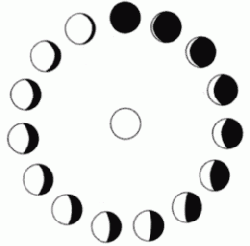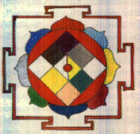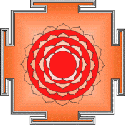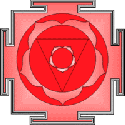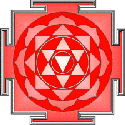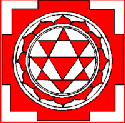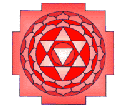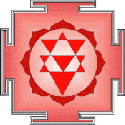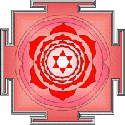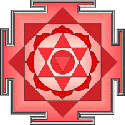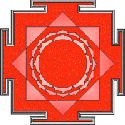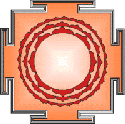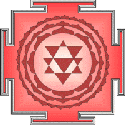Difference between revisions of "The Fifteen Nityas"
m (1 revision: Robo replace 16sept) |
|||
| Line 1: | Line 1: | ||
[[File:Phase2.gif|thumb|250px|]] | [[File:Phase2.gif|thumb|250px|]] | ||
| − | ''"The [[chakra]] of the letters of the [[alphabet]] is based upon [[time]] and so is identical with the sidereal zodiac."'' - '''''Tantraraja [[Tantra]]''''' | + | ''"The [[chakra]] of the letters of the [[alphabet]] is based upon [[time]] and so is identical with the sidereal {{Wiki|zodiac}}."'' - '''''Tantraraja [[Tantra]]''''' |
The Nityas or Eternities of Lalita represent the fifteen lunar days or tithis of the waxing {{Wiki|Moon}}. Each has her own yantra, [[mantra]], [[tantra]] and prayogas or [[ritual]] applications. The full circle of the Nityas also represents the 21,600 breaths a [[human being]] takes in a full day and night. As such, the Nityas are the [[Kalachakra]], or [[Wheel]] of [[Time]]. | The Nityas or Eternities of Lalita represent the fifteen lunar days or tithis of the waxing {{Wiki|Moon}}. Each has her own yantra, [[mantra]], [[tantra]] and prayogas or [[ritual]] applications. The full circle of the Nityas also represents the 21,600 breaths a [[human being]] takes in a full day and night. As such, the Nityas are the [[Kalachakra]], or [[Wheel]] of [[Time]]. | ||
| Line 8: | Line 8: | ||
You can find larger versions of the yantras according to the Tantrarajatantra on this page. | You can find larger versions of the yantras according to the Tantrarajatantra on this page. | ||
| − | The 15 Nityas are modifications of Lalita as red [[goddess]] with her three [[gunas]] and her [[five elements]] of [[aether]], [[air]], [[fire]], [[water]] and [[earth]]. As the {{Wiki|moon}} remains itself, though appearing differently according to phase, so too does Lalita. Each Nitya has her own [[vidya]] (that is [[mantra]]), yantra and group of energies ([[Shaktis]]). Their names appear in the first chapter of Vamakeshvara [[Tantra]]. Gopinath Kaviraj, a renowned [[scholar]] of [[tantra]] in the first half of this century, describes the [[Kalachakra]] and the Nityas succinctly in the introduction to the [[Sanskrit]] edition of [[Yogini]] Hridaya. ([[Sarasvati]] [[Bhavana]] Granthamala, 1963): | + | The 15 Nityas are modifications of Lalita as red [[goddess]] with her three [[gunas]] and her [[five elements]] of [[aether]], [[air]], [[fire]], [[water]] and [[earth]]. As the {{Wiki|moon}} {{Wiki|remains}} itself, though appearing differently according to phase, so too does Lalita. Each Nitya has her own [[vidya]] (that is [[mantra]]), yantra and group of energies ([[Shaktis]]). Their names appear in the first chapter of Vamakeshvara [[Tantra]]. Gopinath Kaviraj, a renowned [[scholar]] of [[tantra]] in the first half of this century, describes the [[Kalachakra]] and the Nityas succinctly in the introduction to the [[Sanskrit]] edition of [[Yogini]] Hridaya. ([[Sarasvati]] [[Bhavana]] Granthamala, 1963): |
[[File:Lalita2.gif|thumb|250px|]] | [[File:Lalita2.gif|thumb|250px|]] | ||
| − | "What the Bhavanopanishad says implies that the [[Human]] [[Body]] is to be conceived as the Sri [[Cakra]], [[being]] the expression of one's own [[self]]. (Svatma). This means that while on the one hand the [[Body]] is to be regarded as non-different from the atma, the entire [[cosmic]] system associated with the [[body]] should also be viewed in the same [[light]]. This outer system in its [[manifestation]] rests on [[Time]] (kala), [[Space]] (deha) and a combination of the two. The exponents of the School hold that the well known fifteen Kalas of the {{Wiki|Moon}}, representing the 15 lunar tithis, are to be regarded as identical with the fifteen Nityas (Kameshvari to Citra). The sixteenth Kala called Sadakhya should be viewed as one with Lalita or the Supreme [[Deity]] Herself. In other words, one has to feel that what appears in [[Kalacakra]] is [[nothing]] but an expression of what [[exists]] eternally as Nityas in the supreme Sri [[Cakra]] itself. The tithicakra or the [[wheel]] of [[time]] is constantly revolving and the Sri [[Cakra]] is within it and not without. It should also be remembered that from the standpoint of an [[esoteric]] [[yogin]] the tithis are in the last analysis to be identified with the 21600 shvasas supposed to be the average number of breaths per day of a normal [[human being]]." | + | "What the Bhavanopanishad says implies that the [[Human]] [[Body]] is to be conceived as the {{Wiki|Sri}} [[Cakra]], [[being]] the expression of one's own [[self]]. (Svatma). This means that while on the one hand the [[Body]] is to be regarded as non-different from the atma, the entire [[cosmic]] system associated with the [[body]] should also be viewed in the same [[light]]. This outer system in its [[manifestation]] rests on [[Time]] ([[kala]]), [[Space]] (deha) and a combination of the two. The exponents of the School hold that the well known fifteen Kalas of the {{Wiki|Moon}}, representing the 15 lunar tithis, are to be regarded as identical with the fifteen Nityas ([[Kameshvari]] to Citra). The sixteenth [[Kala]] called Sadakhya should be viewed as one with Lalita or the [[Supreme]] [[Deity]] Herself. In other words, one has to [[feel]] that what appears in [[Kalacakra]] is [[nothing]] but an expression of what [[exists]] eternally as Nityas in the [[supreme]] {{Wiki|Sri}} [[Cakra]] itself. The tithicakra or the [[wheel]] of [[time]] is constantly revolving and the {{Wiki|Sri}} [[Cakra]] is within it and not without. It should also be remembered that from the standpoint of an [[esoteric]] [[yogin]] the tithis are in the last [[analysis]] to be identified with the 21600 shvasas supposed to be the average number of breaths per day of a normal [[human being]]." |
| − | Hence Lalita or Tripurasundari is the 16th day or [[full moon]], with her 15 digits. Each of the Nityas has a certain number of arms, the totality of arms (= rays) of the whole circle [[being]] [[108]]. Because any unit of [[time]] is taken as a [[microcosm]] or parallel of any other valid unit, each of the fifteen Nityas thus has 1,440 breaths (see Bhavanopanishad). This identity between [[space]], [[time]], Tripurasundari and the {{Wiki|individual}} is elaborated at great length and with considerable {{Wiki|sophistication}} by the author of the Tantraraja. | + | Hence Lalita or Tripurasundari is the 16th day or [[full moon]], with her 15 digits. Each of the Nityas has a certain number of arms, the {{Wiki|totality}} of arms (= rays) of the whole circle [[being]] [[108]]. Because any unit of [[time]] is taken as a [[microcosm]] or parallel of any other valid unit, each of the fifteen Nityas thus has 1,440 breaths (see Bhavanopanishad). This [[identity]] between [[space]], [[time]], Tripurasundari and the {{Wiki|individual}} is elaborated at great length and with considerable {{Wiki|sophistication}} by the author of the Tantraraja. |
| − | According to that text, the Nityas are the vowels of the [[Sanskrit]] [[alphabet]] and are identical with both [[time]] and [[space]]. For example, if the number of tattvas or consonants (36) are multiplied by the 16 Nityas the number of letters is 576. The multiples of this number provide the number of years in the different Yugas. So the circle of the matrikas and the Nityas is identical with the sidereal zodiac as well as [[mantra]]. | + | According to that text, the Nityas are the vowels of the [[Sanskrit]] [[alphabet]] and are identical with both [[time]] and [[space]]. For example, if the number of tattvas or consonants (36) are multiplied by the 16 Nityas the number of letters is 576. The multiples of this number provide the number of years in the different [[Yugas]]. So the circle of the {{Wiki|matrikas}} and the Nityas is identical with the sidereal {{Wiki|zodiac}} as well as [[mantra]]. |
| − | This theme is further elaborated in the 28th chapter of the same [[tantra]], where {{Wiki|Shiva}} says that in the centre of the [[world]] is the [[Meru]], outside of this [[being]] the seven oceans and beyond this the [[Kalachakra]] or [[wheel]] of [[time]] which moves in a clockwise [[direction]] by the [[power]] of Iccha (Will) [[Shakti]]. The circle is divided by 12 spokes and the {{Wiki|planets}} or grahas are within this. Lalita, says the [[tantra]], is in the [[Meru]], while 14 Nityas from Kameshvari to Jvalamalini reside in the seven islands and seven oceans. Chitra, who is the 16th Nitya, occupies supreme [[Space]] or Paramavyoma. | + | This theme is further elaborated in the 28th chapter of the same [[tantra]], where {{Wiki|Shiva}} says that in the centre of the [[world]] is the [[Meru]], outside of this [[being]] the seven oceans and [[beyond]] this the [[Kalachakra]] or [[wheel]] of [[time]] which moves in a clockwise [[direction]] by the [[power]] of Iccha (Will) [[Shakti]]. The circle is divided by 12 spokes and the {{Wiki|planets}} or [[grahas]] are within this. Lalita, says the [[tantra]], is in the [[Meru]], while 14 Nityas from [[Kameshvari]] to Jvalamalini reside in the seven islands and seven oceans. Chitra, who is the 16th Nitya, occupies [[supreme]] [[Space]] or Paramavyoma. |
| − | In the Dakshinamurti Samhita, the Nityas are identified with kalas or parts of the different stages of deep [[sleep]], dreaming, waking, and full [[consciousness]] or Turiya. Here it is said that the Nityas, including Lalita, are the 16 parts of the {{Wiki|continuum}} of [[consciousness]], while the 17th Kala is beyond all of this. Each of the Nityas has the respective vowel [[letter]] associated with her [[mantra]] [[vidya]]. | + | In the Dakshinamurti Samhita, the Nityas are identified with kalas or parts of the different stages of deep [[sleep]], dreaming, waking, and full [[consciousness]] or Turiya. Here it is said that the Nityas, including Lalita, are the 16 parts of the {{Wiki|continuum}} of [[consciousness]], while the 17th [[Kala]] is [[beyond]] all of this. Each of the Nityas has the respective vowel [[letter]] associated with her [[mantra]] [[vidya]]. |
{| class="wikitable" | {| class="wikitable" | ||
|- | |- | ||
| − | |Vowels || {{Wiki|Moon}} || Deep Sleep|| 14 spokes ||[[Prameya]] | + | |Vowels || {{Wiki|Moon}} || Deep [[Sleep]]|| 14 spokes ||[[Prameya]] |
|- | |- | ||
|Consonants || {{Wiki|Sun}} || Waking || Two 10s ||[[Pramana]] | |Consonants || {{Wiki|Sun}} || Waking || Two 10s ||[[Pramana]] | ||
| Line 35: | Line 35: | ||
|- | |- | ||
| − | |Eight petals ||Fire || [[Dream]] || ||[[Pramana]] | + | |Eight petals ||[[Fire]] || [[Dream]] || ||[[Pramana]] |
|- | |- | ||
| Line 41: | Line 41: | ||
|- | |- | ||
| − | |Visarga || Trikona || Blossoming [[universal]] place, Kriya | + | |Visarga || [[Trikona]] || Blossoming [[universal]] place, [[Kriya]] |
|- | |- | ||
| − | |[[Bindu]] || [[Bindu]] || Non blossoming place, [[Jnana]] | + | |[[Bindu]] || [[Bindu]] || [[Non]] blossoming place, [[Jnana]] |
|- | |- | ||
| Line 50: | Line 50: | ||
|} | |} | ||
| − | Similar ideas are found in the Matrikachakra Viveka, as in the table above, drawn from the [[Sanskrit]] introduction to the 1934 Government [[Sanskrit]] College of [[Benares]] edition, which classifies the nine [[mandalas]] of the Shri Yantra according to [[Pramana]] - means of [[knowledge]], Pramata - the subject, and [[Prameya]] - [[the object]] and relates the different states of [[consciousness]] to the yantra. | + | Similar [[ideas]] are found in the Matrikachakra Viveka, as in the table above, drawn from the [[Sanskrit]] introduction to the 1934 Government [[Sanskrit]] College of [[Benares]] edition, which classifies the nine [[mandalas]] of the Shri Yantra according to [[Pramana]] - means of [[knowledge]], Pramata - the [[subject]], and [[Prameya]] - [[the object]] and relates the different states of [[consciousness]] to the yantra. |
[[File:Lalita1.gif|thumb|250px|]] | [[File:Lalita1.gif|thumb|250px|]] | ||
| − | According to the Tantraraja, the 15 Nityas are limbs or rays of Lalita, who is herself [[pure consciousness]] without additions. Varahi and [[Kurukulla]] bear the relationship of father and mother respectively. The Nityas themselves can be [[meditated]] upon and worshipped in different [[forms]] and colours for the [[attainment]] of different ends. In daily worship ([[puja]]) of the Nityas, each has her own nyasa and [[ritual]] sequence and they are to receive [[puja]] on the lunar days associated with them. The [[vidya]] [[mantras]] of the different Nityas below are prefaced by [[Aim]] Hrim Shrim [[bija]] [[mantras]] and suffixed with Shri Padukam Pujayami Tarpayami Namah, that is Hail. I worship and libate the [[auspicious]] [[lotus]] feet [of the appropriate Nitya]. The yantras used below are those from the Tantraraja while the [[Sanskrit]] syllables are the vowel letters associated with each Nitya and day of the {{Wiki|Moon}}. | + | According to the Tantraraja, the 15 Nityas are limbs or rays of Lalita, who is herself [[pure consciousness]] without additions. Varahi and [[Kurukulla]] bear the relationship of father and mother respectively. The Nityas themselves can be [[meditated]] upon and worshipped in different [[forms]] and colours for the [[attainment]] of different ends. In daily {{Wiki|worship}} ([[puja]]) of the Nityas, each has her own nyasa and [[ritual]] sequence and they are to receive [[puja]] on the lunar days associated with them. The [[vidya]] [[mantras]] of the different Nityas below are prefaced by [[Aim]] Hrim Shrim [[bija]] [[mantras]] and suffixed with Shri Padukam Pujayami Tarpayami Namah, that is Hail. I {{Wiki|worship}} and libate the [[auspicious]] [[lotus]] feet [of the [[appropriate]] Nitya]. The yantras used below are those from the Tantraraja while the [[Sanskrit]] syllables are the vowel letters associated with each Nitya and day of the {{Wiki|Moon}}. |
| − | The images embedded in the text above are taken from a sadhaka's manuscript of the 1,000 names of Lalita. | + | The images embedded in the text above are taken from a sadhaka's {{Wiki|manuscript}} of the 1,000 names of Lalita. |
| − | ====Kameshvari Nitya==== | + | ====[[Kameshvari]] Nitya==== |
[[File:Kamesh2.gif|thumb|250px|]] | [[File:Kamesh2.gif|thumb|250px|]] | ||
| − | The first Nitya in the cycle is Kameshvari, a name which means Lady of [[Desire]]. Her [[vidya]] ([[mantra]]) according to the Tantrarajatantra, is [[Aim]] Hrim Shrim Am [[Aim]] Sa Ka La Hrim Nityaklinne Madadrave Sauh Am Kameshvari Nitya Shri Padukam Pujayami Tarpayami Namah. | + | The first Nitya in the cycle is [[Kameshvari]], a [[name]] which means Lady of [[Desire]]. Her [[vidya]] ([[mantra]]) according to the Tantrarajatantra, is [[Aim]] Hrim Shrim Am [[Aim]] Sa Ka La Hrim Nityaklinne Madadrave Sauh Am [[Kameshvari]] Nitya Shri Padukam Pujayami Tarpayami Namah. |
| − | The same [[tantra]] gives her [[dhyana]] or [[meditation]] image as red like 10 million dawn suns, having a diadem of rubies, wearing throat ornaments, necklaces, waistchains and rings. She is red, has six arms and three [[eyes]], and bears a crescent {{Wiki|Moon}}, smiling softly. She holds a bow of sugar cane, flowering arrows, noose, goad, and a nectar-filled begemmed cup, showing the [[mudra]] of bestowing boons. The five arrows of [[desire]] ([[Kama]]) in the five petals are Longing, Maddening, Kindling, Enchanting and Wasting. These five Kamas are five [[forms]] of [[Kamadeva]], Lalita as {{Wiki|Krishna}}, who are Kamaraja (Hrim), Manmatha (Klim), Kandarpa ([[Aim]]), [[Makara]] (Blum) and Manobhava (Strim) with the colours yellow, white, red, purple and blue. Each of the Kamadevas has two [[eyes]] and two arms, the hands [[holding]] sugar cane bow and flowering arrows, the very [[form]] of the [[five elements]]. | + | The same [[tantra]] gives her [[dhyana]] or [[meditation]] {{Wiki|image}} as red like 10 million dawn suns, having a diadem of rubies, wearing [[throat]] ornaments, necklaces, waistchains and rings. She is red, has six arms and three [[eyes]], and bears a crescent {{Wiki|Moon}}, smiling softly. She holds a bow of sugar cane, flowering arrows, noose, goad, and a nectar-filled begemmed cup, showing the [[mudra]] of bestowing boons. The five arrows of [[desire]] ([[Kama]]) in the five petals are [[Longing]], Maddening, Kindling, Enchanting and Wasting. These five Kamas are five [[forms]] of [[Kamadeva]], Lalita as {{Wiki|Krishna}}, who are Kamaraja (Hrim), [[Manmatha]] (Klim), [[Kandarpa]] ([[Aim]]), [[Makara]] (Blum) and Manobhava (Strim) with the colours yellow, white, red, purple and blue. Each of the Kamadevas has two [[eyes]] and two arms, the hands [[holding]] sugar cane bow and flowering arrows, the very [[form]] of the [[five elements]]. |
====Bhagamalini Nitya==== | ====Bhagamalini Nitya==== | ||
[[File:Bhaga.gif|thumb|250px|]] | [[File:Bhaga.gif|thumb|250px|]] | ||
| − | Nitya Bhagamalini, whose name refers to the flowering yoni, is the second of the cycle of the waxing {{Wiki|Moon}} and has a remarkable and very long [[vidya]] ([[mantra]]) which runs: [[Aim]] Hrim Shrim Am [[Aim]] Bhagabuge Bhagini Bhagodari Bhagamale Bhagavahe Bhagaguhye Bhagayoni Bhaganipatini Sarvabhagavashankari Bhagarupe Nityaklinne Bhagasvarupe Sarvani Bhagani Me Hyanaya Varade Rete Surete Bhagaklinne Klinnadrave Kledaya Dravaya Amoghe Bhagavicce Kshubha Kshobhaya Sarvasatvan Bhagodari [[Aim]] Blum Jem Blum Bhem Blum Mom Blum Hem Blum Hem Klinne Sarvani Bhagani Me Vashamanaya Strim Hara Blem Hrim Am Bhagamalini Nitya Shri Padukam Pujayami Tarpayami Namah. | + | Nitya Bhagamalini, whose [[name]] refers to the flowering [[yoni]], is the second of the cycle of the waxing {{Wiki|Moon}} and has a remarkable and very long [[vidya]] ([[mantra]]) which runs: [[Aim]] Hrim Shrim Am [[Aim]] Bhagabuge Bhagini Bhagodari Bhagamale Bhagavahe Bhagaguhye Bhagayoni Bhaganipatini Sarvabhagavashankari Bhagarupe Nityaklinne Bhagasvarupe Sarvani Bhagani Me Hyanaya Varade Rete Surete Bhagaklinne Klinnadrave Kledaya Dravaya Amoghe Bhagavicce Kshubha Kshobhaya Sarvasatvan Bhagodari [[Aim]] Blum Jem Blum Bhem Blum Mom Blum Hem Blum Hem Klinne Sarvani Bhagani Me Vashamanaya Strim Hara Blem Hrim Am Bhagamalini Nitya Shri Padukam Pujayami Tarpayami Namah. |
She has six arms, three [[eyes]], sits on a [[lotus]] and holds in her left hands a night [[water]] lily, a noose and a sugar cane bow and in her right a [[lotus]], a goad and flowering arrows. Around her is a host of [[Shaktis]] all of whom look like her, according to the Tantrarajatantra. | She has six arms, three [[eyes]], sits on a [[lotus]] and holds in her left hands a night [[water]] lily, a noose and a sugar cane bow and in her right a [[lotus]], a goad and flowering arrows. Around her is a host of [[Shaktis]] all of whom look like her, according to the Tantrarajatantra. | ||
| − | The Dakshinamurti Samhita has a different image ([[dhyana]]). Here (chapter 41), she is described as dwelling in the middle of a flowery forest, adorned with various [[gems]], [[holding]] noose, goad, [[book]], scales, nail (?) and [[writing]] implement, showing the [[mudras]] or hand gestures of allaying {{Wiki|fears}} and bestowing boons. Her yantra is described differently, too, as triangle, hexagon, 16 petals, eight petals, then the bhupura or fence. | + | The Dakshinamurti Samhita has a different {{Wiki|image}} ([[dhyana]]). Here (chapter 41), she is described as dwelling in the middle of a flowery {{Wiki|forest}}, adorned with various [[gems]], [[holding]] noose, goad, [[book]], scales, nail (?) and [[writing]] implement, showing the [[mudras]] or hand gestures of allaying {{Wiki|fears}} and bestowing boons. Her yantra is described differently, too, as triangle, hexagon, 16 petals, eight petals, then the bhupura or fence. |
====Nityaklinna Nitya==== | ====Nityaklinna Nitya==== | ||
[[File:Nityak2.gif|thumb|250px|]] | [[File:Nityak2.gif|thumb|250px|]] | ||
| − | Her name means Wet Nitya, or Always Wet. The third Nitya's [[mantra]] is [[Aim]] Hrim Shrim Nityaklinne Madadrave [[Svaha]] im Nityaklinna Nitya Shri Padukam Pujayami Tarpayami Namah. | + | Her [[name]] means Wet Nitya, or Always Wet. The third Nitya's [[mantra]] is [[Aim]] Hrim Shrim Nityaklinne Madadrave [[Svaha]] im Nityaklinna Nitya Shri Padukam Pujayami Tarpayami Namah. |
| − | She is surrounded by 19 [[Shaktis]], according to the Tantraraja, who are Kshobhini, Mohini, Lila, Nitya, Niranjana, Klinna, Kledini, Madanatura, Madadrava, Dravini, Vidhana, Madavila, [[Mangala]], Manmatharta, Manashvini, [[Moha]], Amoda, Manomayi, [[Maya]]a and Manovati. The Nityaklinna herself, the same [[tantra]] says, is restless with [[desire]], smeared with red sandal paste, wears red [[clothes]], [[smiles]], has a half {{Wiki|moon}} on her head, and holds noose, goad, cup and makes the [[mudra]] dispelling {{Wiki|fear}}. | + | She is surrounded by 19 [[Shaktis]], according to the Tantraraja, who are Kshobhini, Mohini, Lila, Nitya, Niranjana, Klinna, Kledini, Madanatura, Madadrava, Dravini, Vidhana, Madavila, [[Mangala]], Manmatharta, Manashvini, [[Moha]], Amoda, Manomayi, [[Maya]]a and Manovati. The Nityaklinna herself, the same [[tantra]] says, is restless with [[desire]], smeared with red sandal paste, wears red [[clothes]], [[smiles]], has a half {{Wiki|moon}} on her {{Wiki|head}}, and holds noose, goad, cup and makes the [[mudra]] dispelling {{Wiki|fear}}. |
| − | The Dakshinamurti Samhita (chapter 42) gives her [[root]] [[mantra]] as [[being]] of 11 syllables, Hrim Nityaklinna Madadrave [[Svaha]]. The image is similar except that she holds a noose, a goad, a skull and dispels {{Wiki|fears}}. Her face is bathed in sweat and her [[eyes]] move with [[desire]]. Here the yantra is described as trikona, eight petals, and [[earth]] square (bhupura). She bestows [[enjoyment]] and [[liberation]] and subdues the three [[worlds]] for one [[siddha]] (successful) in her [[vidya]] ([[mantra]]). | + | The Dakshinamurti Samhita (chapter 42) gives her [[root]] [[mantra]] as [[being]] of 11 syllables, Hrim Nityaklinna Madadrave [[Svaha]]. The {{Wiki|image}} is similar except that she holds a noose, a goad, a skull and dispels {{Wiki|fears}}. Her face is bathed in {{Wiki|sweat}} and her [[eyes]] move with [[desire]]. Here the yantra is described as [[trikona]], eight petals, and [[earth]] square (bhupura). She bestows [[enjoyment]] and [[liberation]] and subdues the three [[worlds]] for one [[siddha]] (successful) in her [[vidya]] ([[mantra]]). |
====Bherunda Nitya==== | ====Bherunda Nitya==== | ||
[[File:Bherund2.gif|thumb|250px|]] | [[File:Bherund2.gif|thumb|250px|]] | ||
| − | Bherunda, the fourth Nitya, has three [[eyes]] and eight arms, with her [[body]] the colour of molten {{Wiki|gold}}, wearing [[beautiful]] ornaments on her hands, feet, arms and around her waist. She [[smiles]] sweetly with her hands [[holding]] noose, goad, shield, sword, mace, [[thunderbolt]] ([[vajra]]), bow and arrow. | + | Bherunda, the fourth Nitya, has three [[eyes]] and eight arms, with her [[body]] the {{Wiki|colour}} of molten {{Wiki|gold}}, wearing [[beautiful]] ornaments on her hands, feet, arms and around her waist. She [[smiles]] sweetly with her hands [[holding]] noose, goad, shield, sword, mace, [[thunderbolt]] ([[vajra]]), bow and arrow. |
The [[vidya]] [[mantra]] is: [[Aim]] Hrim Shrim Im Om Krom Bhrom Kraum Jhmraum Cchraum Jraum [[Svaha]] Im Bherunda Nitya Shri Padukam Pujayami Tarpayami Namah, says Tantraraja. Using her [[mantra]] destroys [[poison]]. | The [[vidya]] [[mantra]] is: [[Aim]] Hrim Shrim Im Om Krom Bhrom Kraum Jhmraum Cchraum Jraum [[Svaha]] Im Bherunda Nitya Shri Padukam Pujayami Tarpayami Namah, says Tantraraja. Using her [[mantra]] destroys [[poison]]. | ||
| Line 88: | Line 88: | ||
====Vahnivasini Nitya==== | ====Vahnivasini Nitya==== | ||
[[File:Vahni2.gif|thumb|250px|]] | [[File:Vahni2.gif|thumb|250px|]] | ||
| − | Vahnivasini is the sixth Nitya (Eternity) in the cycle, her name meaning the dweller in [[fire]]. Her [[mantra]] is Om Hrim Vahnivasiniyai Namah. The [[Shaktis]] in the eight trikonas are Jvalini, Visphulingini, [[Mangala]], Sumanohara, Kanaka, Ankita, Vishva and Vividha. In the 12 petals are the 12 signs of the [[Hindu]] (sidereal)zodiac. Her description in the Tantraraja [[Tantra]] is as a [[beautiful]] young woman, the colour of {{Wiki|gold}}, with eight arms, dressed in yellow silk garments, adorned with rubies. She holds a red [[lotus]], a [[conch]], a bow of red sugarcane and the [[full moon]] in her left hands; in her right a white [[water]] lily, golden horn, flowery arrows and a citron. Around her are numberless [[Shaktis]] who look like her. She is the dweller in [[fire]] who devours the [[universe]]. | + | Vahnivasini is the sixth Nitya ({{Wiki|Eternity}}) in the cycle, her [[name]] [[meaning]] the dweller in [[fire]]. Her [[mantra]] is Om Hrim Vahnivasiniyai Namah. The [[Shaktis]] in the eight trikonas are Jvalini, Visphulingini, [[Mangala]], Sumanohara, Kanaka, Ankita, Vishva and Vividha. In the 12 petals are the 12 signs of the [[Hindu]] (sidereal)zodiac. Her description in the Tantraraja [[Tantra]] is as a [[beautiful]] young woman, the {{Wiki|colour}} of {{Wiki|gold}}, with eight arms, dressed in yellow silk garments, adorned with rubies. She holds a red [[lotus]], a [[conch]], a bow of red sugarcane and the [[full moon]] in her left hands; in her right a white [[water]] lily, golden horn, flowery arrows and a citron. Around her are numberless [[Shaktis]] who look like her. She is the dweller in [[fire]] who devours the [[universe]]. |
====Mahavajreshvari Nitya==== | ====Mahavajreshvari Nitya==== | ||
| Line 94: | Line 94: | ||
Her vidya-mantra is Um Hrim Klinne [[Aim]] Krom Nityamadadrave Hrim Um Mahavajreshvari Nitya Shri Padukam Pujayami Tarpayami Namah. | Her vidya-mantra is Um Hrim Klinne [[Aim]] Krom Nityamadadrave Hrim Um Mahavajreshvari Nitya Shri Padukam Pujayami Tarpayami Namah. | ||
| − | She is described in the Tantraraja as having four arms, three [[eyes]], garmented in red, red in colour, wearing red jewels and strewn with red flowers, wearing a crown of rubies. She sits on a throne on a golden boat which floats on an ocean of blood, and holds noose, goad, sugar cane bow and flowering arrows. She is surrounded by a host of [[Shaktis]] similar to her and sways while she [[smiles]] mercifully. | + | She is described in the Tantraraja as having four arms, three [[eyes]], garmented in red, red in {{Wiki|colour}}, wearing red jewels and strewn with red [[flowers]], wearing a {{Wiki|crown}} of rubies. She sits on a [[throne]] on a golden boat which floats on an ocean of {{Wiki|blood}}, and holds noose, goad, sugar cane bow and flowering arrows. She is surrounded by a host of [[Shaktis]] similar to her and sways while she [[smiles]] mercifully. |
The description in the DS differs. Here, she is described as resembling the [[china]] rose, wearing red [[clothes]], and [[holding]] noose, goad, skull and dispelling {{Wiki|fear}}. She is swaying from having drunk [[pure]] wine. The yantra here is described as having a triangle, four petals, eight petals and a bhupura. | The description in the DS differs. Here, she is described as resembling the [[china]] rose, wearing red [[clothes]], and [[holding]] noose, goad, skull and dispelling {{Wiki|fear}}. She is swaying from having drunk [[pure]] wine. The yantra here is described as having a triangle, four petals, eight petals and a bhupura. | ||
| Line 102: | Line 102: | ||
According to Nityotsava, an expansion of the Kalpasutras, the vidya-mantra of Shivaduti Nitya is [[Aim]] Hrim Shrim Shivadutyai Namah Shivadutinitya Shri Padukam Pujayami Tarpayami Namah. She is called Shivaduti because she makes {{Wiki|Shiva}} her messenger (Duti). | According to Nityotsava, an expansion of the Kalpasutras, the vidya-mantra of Shivaduti Nitya is [[Aim]] Hrim Shrim Shivadutyai Namah Shivadutinitya Shri Padukam Pujayami Tarpayami Namah. She is called Shivaduti because she makes {{Wiki|Shiva}} her messenger (Duti). | ||
| − | The Tantraraja describes her as [[being]] dressed in red, with nine jewels in her crown, surrounded by {{Wiki|Rishis}} singing her praises and having eight arms and three [[eyes]]. She looks as bright as the summer {{Wiki|sun}} at midday and [[smiles]] sweetly. Her hands hold horn, shield, mace, cup, goad, cleaver, axe and [[lotus]]. | + | The Tantraraja describes her as [[being]] dressed in red, with [[nine jewels]] in her {{Wiki|crown}}, surrounded by {{Wiki|Rishis}} singing her praises and having eight arms and three [[eyes]]. She looks as bright as the summer {{Wiki|sun}} at midday and [[smiles]] sweetly. Her hands hold horn, shield, mace, cup, goad, cleaver, axe and [[lotus]]. |
====Tvarita Nitya==== | ====Tvarita Nitya==== | ||
[[File:Tvar2.gif|thumb|250px|]] | [[File:Tvar2.gif|thumb|250px|]] | ||
| − | Tvarita is the ninth Nitya (Eternity) in the cycle. Also called Totala [[Devi]]. She is called Tvarita ("Swift") as She grants [[fruit]] to the [[sadhaka]] quickly. She is of [[auspicious]] [[form]], in the first flush of youth, and dark in colour. She has 3 [[eyes]] and 4 hands and Her [[beautiful]] [[lotus]]- like face [[smiles]] gently. She is clad in new leaves. She is adorned with 8 fierce and great serpents of 4 kinds, and with waist chains and anklets. On Her head is a crystal crown with a crest of [[peacock]] feathers. Her arms are adorned with bangles made of [[beautiful]] [[peacock]] feathers. She has an umbrella and a banner made of [[peacock]] feathers. She wears strings of (red) gunja berries around Her throat, and Her breasts are smeared with red sandal and kumkum. She holds noose, goad, dispels {{Wiki|fear}}, and grants boons. | + | Tvarita is the ninth Nitya ({{Wiki|Eternity}}) in the cycle. Also called Totala [[Devi]]. She is called Tvarita ("Swift") as She grants [[fruit]] to the [[sadhaka]] quickly. She is of [[auspicious]] [[form]], in the first flush of youth, and dark in {{Wiki|colour}}. She has 3 [[eyes]] and 4 hands and Her [[beautiful]] [[lotus]]- like face [[smiles]] gently. She is clad in new leaves. She is adorned with 8 fierce and great serpents of 4 kinds, and with waist chains and anklets. On Her {{Wiki|head}} is a {{Wiki|crystal}} {{Wiki|crown}} with a crest of [[peacock]] feathers. Her arms are adorned with bangles made of [[beautiful]] [[peacock]] feathers. She has an umbrella and a banner made of [[peacock]] feathers. She wears strings of (red) gunja berries around Her [[throat]], and Her breasts are smeared with red sandal and kumkum. She holds noose, goad, dispels {{Wiki|fear}}, and grants boons. |
| − | In front of this [[Goddess]] is a black servant carrying a mace, who is worshipped for the [[attainment]] of the [[desired]] [[fruit]]. On either side of Her are Her two [[Shaktis]] Jaya (conquering) and [[Vijaya]] (Victorious) who are like Her and who carry and swing {{Wiki|gold}} canes. | + | In front of this [[Goddess]] is a black servant carrying a mace, who is worshipped for the [[attainment]] of the [[desired]] [[fruit]]. On either side of Her are Her two [[Shaktis]] [[Jaya]] (conquering) and [[Vijaya]] (Victorious) who are like Her and who carry and swing {{Wiki|gold}} canes. |
| − | The 8 Serpents are: [[Ananta]] & Kulika, fiery in colour, each with 1000 hoods, Her {{Wiki|ear}} ornaments. Vasuki & Shankhapala, yellow in colour, each with 700 hoods, Her upper arm bangles. Takshaka & Mahapadma, blue in colour, each with 500 hoods, Her girdle. [[Padma]] & Kartataka, white, each with 300 hoods, Her toe ornaments. Her [[Shaktis]] are Humkari, Khechari, Chandi, Chedini, Kahepani, Strikari, Dumkari, Kahemakari -- these are similar to the Lokapalas, and the [[Shaktis]] in the 8 petals of the yantra. Her [[mantra]] is Om Hrim Hum Khe Ca Che Ksah Strim Hum Kse Hrim Phat. | + | The 8 Serpents are: [[Ananta]] & Kulika, fiery in {{Wiki|colour}}, each with 1000 hoods, Her {{Wiki|ear}} ornaments. [[Vasuki]] & Shankhapala, yellow in {{Wiki|colour}}, each with 700 hoods, Her upper arm bangles. {{Wiki|Takshaka}} & Mahapadma, blue in {{Wiki|colour}}, each with 500 hoods, Her girdle. [[Padma]] & Kartataka, white, each with 300 hoods, Her toe ornaments. Her [[Shaktis]] are Humkari, Khechari, [[Chandi]], Chedini, Kahepani, Strikari, Dumkari, Kahemakari -- these are similar to the Lokapalas, and the [[Shaktis]] in the 8 petals of the yantra. Her [[mantra]] is Om Hrim Hum Khe Ca Che Ksah Strim Hum Kse Hrim Phat. |
| − | ====Tvarita Puja==== | + | ====Tvarita [[Puja]]==== |
| − | Taking up a position facing East, and having done three pranayamas, one should do the following Nyasa: Hail to the [[Rishi]] Saura on the head: Hail to the Metre Virat on the mouth: Hail to the [[Devi]] Tvarita Nitya in the [[heart]]: Hail to the [[Bija]] Om in the genitals: Hail to the [[Shakti]] Hum on the feet: Hail to the Linchpin Kse on the navel. Then making the [[anjali]] gesture near the [[heart]] one should do the following Nyasa: Cm Khe Ca to the [[heart]] Namah: Ca Cche to the head [[Svaha]]: Cche Ksah to the peak Vasat: Ksah Stri to the armour Hum: Stri Hum to the 3 [[eyes]] Vaushad: Hum Kse to the Missile Phat. | + | Taking up a position facing {{Wiki|East}}, and having done three pranayamas, one should do the following Nyasa: Hail to the [[Rishi]] Saura on the {{Wiki|head}}: Hail to the Metre Virat on the {{Wiki|mouth}}: Hail to the [[Devi]] Tvarita Nitya in the [[heart]]: Hail to the [[Bija]] Om in the genitals: Hail to the [[Shakti]] Hum on the feet: Hail to the Linchpin Kse on the navel. Then making the [[anjali]] gesture near the [[heart]] one should do the following Nyasa: Cm Khe Ca to the [[heart]] Namah: Ca Cche to the {{Wiki|head}} [[Svaha]]: Cche Ksah to the peak Vasat: Ksah Stri to the armour Hum: Stri Hum to the 3 [[eyes]] Vaushad: Hum Kse to the Missile Phat. |
| − | Then one should do the Tvarita Nyasa: (Head) Hrim Om Hrim Namah: (Forehead) Hrum Hum Hrim Namah: (Throat) Hrim Khe Hrim Namah: ([[Heart]]) Hrim Ca Hrim Namah: (Navel) Hrim Cche Hrim Namah: ([[Muladhara]]) Hrim Ksah Hrim Namah: (Thighs) Hrim Stri Hrim Namah: (Knees) Hrim Hum Hrim Namah: (Legs) Hrim Kse Hrim Namah: (Feet) Hrim Phat Hrim Namah: End with a diffusion. | + | Then one should do the Tvarita Nyasa: ({{Wiki|Head}}) Hrim Om Hrim Namah: (Forehead) Hrum Hum Hrim Namah: ([[Throat]]) Hrim Khe Hrim Namah: ([[Heart]]) Hrim Ca Hrim Namah: (Navel) Hrim Cche Hrim Namah: ([[Muladhara]]) Hrim Ksah Hrim Namah: (Thighs) Hrim Stri Hrim Namah: (Knees) Hrim Hum Hrim Namah: (Legs) Hrim Kse Hrim Namah: (Feet) Hrim Phat Hrim Namah: End with a diffusion. |
| − | After placing the yantra in front of you, visualise [[Devi]] Tvarita in the [[heart]]. Take Her to the head, resolve to do Her [[puja]], place the [[flower]] on the yantra centre. Worship the triple [[Guru]] line first, as [[being]] in the three circles, then Devi's servitor who is in the west of the Yantra. Worship Jaya and [[Vijaya]] on both sides of the door. Worship Humkari, Khecari, Canda, Cchedini, Ksepini, Strikari, Dumkari, Ksemakari in the eight petals. Tvarita [[Devi]] in the centre. | + | After placing the yantra in front of you, visualise [[Devi]] Tvarita in the [[heart]]. Take Her to the {{Wiki|head}}, resolve to do Her [[puja]], place the [[flower]] on the yantra centre. {{Wiki|Worship}} the triple [[Guru]] line first, as [[being]] in the three circles, then Devi's servitor who is in the {{Wiki|west}} of the Yantra. {{Wiki|Worship}} [[Jaya]] and [[Vijaya]] on both sides of the door. {{Wiki|Worship}} Humkari, Khecari, Canda, Cchedini, Ksepini, Strikari, Dumkari, Ksemakari in the eight petals. Tvarita [[Devi]] in the centre. |
====Kulasundari Nitya==== | ====Kulasundari Nitya==== | ||
| Line 136: | Line 136: | ||
====Nilapataka Nitya==== | ====Nilapataka Nitya==== | ||
[[File:Nilapa2.gif|thumb|250px|]] | [[File:Nilapa2.gif|thumb|250px|]] | ||
| − | Her name means Sapphire Banner and her [[mantra]] is [[Aim]] Hrim Shrim Phrem Strum Krom Am Klim [[Aim]] Blum Nityamadadrave Hum Phrem Hrim Em Nilapataka Nitya Shri Padukam Pujayami Tarpayami Namah. | + | Her [[name]] means {{Wiki|Sapphire}} Banner and her [[mantra]] is [[Aim]] Hrim Shrim Phrem Strum Krom Am Klim [[Aim]] Blum Nityamadadrave Hum Phrem Hrim Em Nilapataka Nitya Shri Padukam Pujayami Tarpayami Namah. |
| − | The Tantraraja says that she is [[nila]] (sapphire) in hue with five faces and ten arms, wearing red [[clothes]] and [[beautiful]] [[gems]]. Her left hands show noose, banner, shield, horn bow, and the [[mudra]] granting gifts. Her right hands show goad, dart, sword, arrows and the [[mudra]] banishing {{Wiki|fear}}. She sits on a [[lotus]] surrounded by hordes of [[Shaktis]] like her. She rules the Yakshinis and the 64 Chetakas and has an uncanny collection of [[siddhis]] or [[magical]] [[powers]] to grant to her [[sadhaka]] or sadhika including a sword unbeatable in battle (Khadga [[siddhi]]), [[Treasure]], the [[power]] to see through walls (Anjana), the ability to travel miles in an instant (Paduka [[Siddhi]]) and lots, lots more. | + | The Tantraraja says that she is [[nila]] ({{Wiki|sapphire}}) in hue with five faces and [[ten]] arms, wearing red [[clothes]] and [[beautiful]] [[gems]]. Her left hands show noose, banner, shield, horn bow, and the [[mudra]] granting gifts. Her right hands show goad, dart, sword, arrows and the [[mudra]] banishing {{Wiki|fear}}. She sits on a [[lotus]] surrounded by hordes of [[Shaktis]] like her. She rules the [[Yakshinis]] and the 64 Chetakas and has an uncanny collection of [[siddhis]] or [[magical]] [[powers]] to grant to her [[sadhaka]] or sadhika including a sword unbeatable in battle (Khadga [[siddhi]]), [[Treasure]], the [[power]] to see through walls ([[Anjana]]), the ability to travel {{Wiki|miles}} in an instant (Paduka [[Siddhi]]) and lots, lots more. |
====[[Vijaya]] Nitya==== | ====[[Vijaya]] Nitya==== | ||
[[File:Vijaya2.gif|thumb|250px|]] | [[File:Vijaya2.gif|thumb|250px|]] | ||
| − | She brings victory in battle and success in buying and selling, hence her name, Victorious. | + | She brings victory in battle and [[success]] in buying and selling, hence her [[name]], Victorious. |
| − | According to Nityotsava, her [[vidya]] [[mantra]] is [[Aim]] Hrim Shrim Bha Ma Ra Ya Aum [[Aim]] [[Vijaya]] Nitya Shri Padukam Pujayami Tarpayami Namah. According to the DS she has one head and 10 arms and wears a garland of [[human]] skulls but the [[dhyana]] or [[meditation]] image in the Tantraraja differs from this. There she has five heads and 10 arms which hold [[conch]], noose, shield, bow, white lily, discus, goad, arrows and lemon. | + | According to Nityotsava, her [[vidya]] [[mantra]] is [[Aim]] Hrim Shrim Bha Ma Ra Ya [[Aum]] [[Aim]] [[Vijaya]] Nitya Shri Padukam Pujayami Tarpayami Namah. According to the DS she has one {{Wiki|head}} and 10 arms and wears a garland of [[human]] skulls but the [[dhyana]] or [[meditation]] {{Wiki|image}} in the Tantraraja differs from this. There she has five heads and 10 arms which hold [[conch]], noose, shield, bow, white lily, {{Wiki|discus}}, goad, arrows and lemon. |
====Sarvamangala Nitya==== | ====Sarvamangala Nitya==== | ||
[[File:Sarva2.gif|thumb|250px|]] | [[File:Sarva2.gif|thumb|250px|]] | ||
| − | Her name means "all [[auspicious]]" and her [[vidya]] [[mantra]] is [[Aim]] Hrim Shrim Svaum Om Sarvamangala Nitya Shri Padukam Pujayami Tarpayami Namah. She has two arms and one head, sits on her [[lotus]] yantra and has [[eyes]] which represent the {{Wiki|sun}} and the {{Wiki|moon}}, while she [[smiles]] sweetly. In her right hand she holds a citron and with the left shows the boon-giving [[mudra]]. All her 76 attendants surround her, they are solar, lunar and fiery. | + | Her [[name]] means "all [[auspicious]]" and her [[vidya]] [[mantra]] is [[Aim]] Hrim Shrim Svaum Om Sarvamangala Nitya Shri Padukam Pujayami Tarpayami Namah. She has two arms and one {{Wiki|head}}, sits on her [[lotus]] yantra and has [[eyes]] which represent the {{Wiki|sun}} and the {{Wiki|moon}}, while she [[smiles]] sweetly. In her right hand she holds a citron and with the left shows the boon-giving [[mudra]]. All her 76 {{Wiki|attendants}} surround her, they are solar, lunar and fiery. |
| − | She rules over the kalas (parts or digits) of the {{Wiki|sun}} (12), the {{Wiki|moon}} (16) and [[fire]] (10). This numbers 38 and her attendants are doubled because each is with her [[consort]]. | + | She rules over the kalas (parts or digits) of the {{Wiki|sun}} (12), the {{Wiki|moon}} (16) and [[fire]] (10). This numbers 38 and her {{Wiki|attendants}} are doubled because each is with her [[consort]]. |
====Jvalamalini Nitya==== | ====Jvalamalini Nitya==== | ||
[[File:Jvalam2.gif|thumb|250px|]] | [[File:Jvalam2.gif|thumb|250px|]] | ||
| − | Her name means "garlanded with flames" and her [[mantra]], according to Tantrarajatantra, is Om [[namo]] bhagavati Jvalamalini devadevi sarvabhutasamharakarike jatavedasi jvalanti jvala jvala prajvala prajvala Hrim Hrim Hum Ram Ram Ram Ram Ram Ram Ram Jvalamalini Hum Phat [[Svaha]]. | + | Her [[name]] means "garlanded with flames" and her [[mantra]], according to Tantrarajatantra, is Om [[namo]] bhagavati Jvalamalini devadevi sarvabhutasamharakarike jatavedasi jvalanti jvala jvala prajvala prajvala Hrim Hrim Hum Ram Ram Ram Ram Ram Ram Ram Jvalamalini Hum Phat [[Svaha]]. |
As the Nitya of flame, she is surrounded by [[Shaktis]], each of whom resembles her and she herself has a [[body]] of flaming [[fire]], with six faces and 12 arms. Each of her faces, each with three [[eyes]], [[smile]] sweetly. | As the Nitya of flame, she is surrounded by [[Shaktis]], each of whom resembles her and she herself has a [[body]] of flaming [[fire]], with six faces and 12 arms. Each of her faces, each with three [[eyes]], [[smile]] sweetly. | ||
| Line 162: | Line 162: | ||
The DS gives a different yantra to the Tantraraja, with one of the [[mandalas]] having forty rather than 32 petals. | The DS gives a different yantra to the Tantraraja, with one of the [[mandalas]] having forty rather than 32 petals. | ||
| − | The [[Shaktis]] and her description also show variants. She is described as sitting on a lion-seat, and holds different [[weapons]] which include the [[damaru]] drum and a jar of wine. | + | The [[Shaktis]] and her description also show variants. She is described as sitting on a lion-seat, and holds different [[weapons]] which include the [[damaru]] [[drum]] and a jar of wine. |
====Chitra Nitya==== | ====Chitra Nitya==== | ||
[[File:Chitra2.gif|thumb|250px|]] | [[File:Chitra2.gif|thumb|250px|]] | ||
| − | The last Nitya in the cycle is Chitra, whose [[mantra]] is [[Aim]] Hrim Shrim Ckaum Am Chitra Nitya Shri Padukam Pujayami Tarpayami Namah. Her name means variegated and she wears a silk garment of different colours, has four arms, one head and holds noose, goad, and shows the gestures granting boons and dispelling {{Wiki|fears}}. | + | The last Nitya in the cycle is Chitra, whose [[mantra]] is [[Aim]] Hrim Shrim Ckaum Am Chitra Nitya Shri Padukam Pujayami Tarpayami Namah. Her [[name]] means variegated and she wears a silk garment of different colours, has four arms, one {{Wiki|head}} and holds noose, goad, and shows the gestures granting boons and dispelling {{Wiki|fears}}. |
{{R}} | {{R}} | ||
Revision as of 21:14, 16 September 2013
"The chakra of the letters of the alphabet is based upon time and so is identical with the sidereal zodiac." - Tantraraja Tantra
The Nityas or Eternities of Lalita represent the fifteen lunar days or tithis of the waxing Moon. Each has her own yantra, mantra, tantra and prayogas or ritual applications. The full circle of the Nityas also represents the 21,600 breaths a human being takes in a full day and night. As such, the Nityas are the Kalachakra, or Wheel of Time.
The information in this section is drawn from a number of tantras including the Tantraraja, the Dakshinamurti Samhita and the Jnanarnava Tantra, as well as the Kalpasutra, which seems to be the primary source. Readers will also find it useful to refer to Sir John Woodroffe's digest of the Tantraraja (Ganesh & Co, 1971), although here he fails to give sufficient idea of the number of prayogas (magical rites) associated with the Nityas. Yantras and mantras, where given, are drawn from Tantraraja, although it is necessary to point out that the Dakshinamurti Samhita gives somewhat different versions.
You can find larger versions of the yantras according to the Tantrarajatantra on this page.
The 15 Nityas are modifications of Lalita as red goddess with her three gunas and her five elements of aether, air, fire, water and earth. As the moon remains itself, though appearing differently according to phase, so too does Lalita. Each Nitya has her own vidya (that is mantra), yantra and group of energies (Shaktis). Their names appear in the first chapter of Vamakeshvara Tantra. Gopinath Kaviraj, a renowned scholar of tantra in the first half of this century, describes the Kalachakra and the Nityas succinctly in the introduction to the Sanskrit edition of Yogini Hridaya. (Sarasvati Bhavana Granthamala, 1963):
"What the Bhavanopanishad says implies that the Human Body is to be conceived as the Sri Cakra, being the expression of one's own self. (Svatma). This means that while on the one hand the Body is to be regarded as non-different from the atma, the entire cosmic system associated with the body should also be viewed in the same light. This outer system in its manifestation rests on Time (kala), Space (deha) and a combination of the two. The exponents of the School hold that the well known fifteen Kalas of the Moon, representing the 15 lunar tithis, are to be regarded as identical with the fifteen Nityas (Kameshvari to Citra). The sixteenth Kala called Sadakhya should be viewed as one with Lalita or the Supreme Deity Herself. In other words, one has to feel that what appears in Kalacakra is nothing but an expression of what exists eternally as Nityas in the supreme Sri Cakra itself. The tithicakra or the wheel of time is constantly revolving and the Sri Cakra is within it and not without. It should also be remembered that from the standpoint of an esoteric yogin the tithis are in the last analysis to be identified with the 21600 shvasas supposed to be the average number of breaths per day of a normal human being."
Hence Lalita or Tripurasundari is the 16th day or full moon, with her 15 digits. Each of the Nityas has a certain number of arms, the totality of arms (= rays) of the whole circle being 108. Because any unit of time is taken as a microcosm or parallel of any other valid unit, each of the fifteen Nityas thus has 1,440 breaths (see Bhavanopanishad). This identity between space, time, Tripurasundari and the individual is elaborated at great length and with considerable sophistication by the author of the Tantraraja.
According to that text, the Nityas are the vowels of the Sanskrit alphabet and are identical with both time and space. For example, if the number of tattvas or consonants (36) are multiplied by the 16 Nityas the number of letters is 576. The multiples of this number provide the number of years in the different Yugas. So the circle of the matrikas and the Nityas is identical with the sidereal zodiac as well as mantra.
This theme is further elaborated in the 28th chapter of the same tantra, where Shiva says that in the centre of the world is the Meru, outside of this being the seven oceans and beyond this the Kalachakra or wheel of time which moves in a clockwise direction by the power of Iccha (Will) Shakti. The circle is divided by 12 spokes and the planets or grahas are within this. Lalita, says the tantra, is in the Meru, while 14 Nityas from Kameshvari to Jvalamalini reside in the seven islands and seven oceans. Chitra, who is the 16th Nitya, occupies supreme Space or Paramavyoma.
In the Dakshinamurti Samhita, the Nityas are identified with kalas or parts of the different stages of deep sleep, dreaming, waking, and full consciousness or Turiya. Here it is said that the Nityas, including Lalita, are the 16 parts of the continuum of consciousness, while the 17th Kala is beyond all of this. Each of the Nityas has the respective vowel letter associated with her mantra vidya.
| Vowels | Moon | Deep Sleep | 14 spokes | Prameya |
| Consonants | Sun | Waking | Two 10s | Pramana |
| Ya etc. | Fire | Dream | Eight spokes | Pramata |
| Sha etc | Fire | Fourth | Four lines | |
| 16 Petals | Fire | Waking | Pramata | |
| Eight petals | Fire | Dream | Pramana | |
| Three lines | Fire | Deep Sleep | Prameya | |
| Visarga | Trikona | Blossoming universal place, Kriya | ||
| Bindu | Bindu | Non blossoming place, Jnana | ||
| Visargabindu | Mahabindu | Place of Samarasa |
Similar ideas are found in the Matrikachakra Viveka, as in the table above, drawn from the Sanskrit introduction to the 1934 Government Sanskrit College of Benares edition, which classifies the nine mandalas of the Shri Yantra according to Pramana - means of knowledge, Pramata - the subject, and Prameya - the object and relates the different states of consciousness to the yantra.
According to the Tantraraja, the 15 Nityas are limbs or rays of Lalita, who is herself pure consciousness without additions. Varahi and Kurukulla bear the relationship of father and mother respectively. The Nityas themselves can be meditated upon and worshipped in different forms and colours for the attainment of different ends. In daily worship (puja) of the Nityas, each has her own nyasa and ritual sequence and they are to receive puja on the lunar days associated with them. The vidya mantras of the different Nityas below are prefaced by Aim Hrim Shrim bija mantras and suffixed with Shri Padukam Pujayami Tarpayami Namah, that is Hail. I worship and libate the auspicious lotus feet [of the appropriate Nitya]. The yantras used below are those from the Tantraraja while the Sanskrit syllables are the vowel letters associated with each Nitya and day of the Moon.
The images embedded in the text above are taken from a sadhaka's manuscript of the 1,000 names of Lalita.
Kameshvari Nitya
The first Nitya in the cycle is Kameshvari, a name which means Lady of Desire. Her vidya (mantra) according to the Tantrarajatantra, is Aim Hrim Shrim Am Aim Sa Ka La Hrim Nityaklinne Madadrave Sauh Am Kameshvari Nitya Shri Padukam Pujayami Tarpayami Namah.
The same tantra gives her dhyana or meditation image as red like 10 million dawn suns, having a diadem of rubies, wearing throat ornaments, necklaces, waistchains and rings. She is red, has six arms and three eyes, and bears a crescent Moon, smiling softly. She holds a bow of sugar cane, flowering arrows, noose, goad, and a nectar-filled begemmed cup, showing the mudra of bestowing boons. The five arrows of desire (Kama) in the five petals are Longing, Maddening, Kindling, Enchanting and Wasting. These five Kamas are five forms of Kamadeva, Lalita as Krishna, who are Kamaraja (Hrim), Manmatha (Klim), Kandarpa (Aim), Makara (Blum) and Manobhava (Strim) with the colours yellow, white, red, purple and blue. Each of the Kamadevas has two eyes and two arms, the hands holding sugar cane bow and flowering arrows, the very form of the five elements.
Bhagamalini Nitya
Nitya Bhagamalini, whose name refers to the flowering yoni, is the second of the cycle of the waxing Moon and has a remarkable and very long vidya (mantra) which runs: Aim Hrim Shrim Am Aim Bhagabuge Bhagini Bhagodari Bhagamale Bhagavahe Bhagaguhye Bhagayoni Bhaganipatini Sarvabhagavashankari Bhagarupe Nityaklinne Bhagasvarupe Sarvani Bhagani Me Hyanaya Varade Rete Surete Bhagaklinne Klinnadrave Kledaya Dravaya Amoghe Bhagavicce Kshubha Kshobhaya Sarvasatvan Bhagodari Aim Blum Jem Blum Bhem Blum Mom Blum Hem Blum Hem Klinne Sarvani Bhagani Me Vashamanaya Strim Hara Blem Hrim Am Bhagamalini Nitya Shri Padukam Pujayami Tarpayami Namah.
She has six arms, three eyes, sits on a lotus and holds in her left hands a night water lily, a noose and a sugar cane bow and in her right a lotus, a goad and flowering arrows. Around her is a host of Shaktis all of whom look like her, according to the Tantrarajatantra.
The Dakshinamurti Samhita has a different image (dhyana). Here (chapter 41), she is described as dwelling in the middle of a flowery forest, adorned with various gems, holding noose, goad, book, scales, nail (?) and writing implement, showing the mudras or hand gestures of allaying fears and bestowing boons. Her yantra is described differently, too, as triangle, hexagon, 16 petals, eight petals, then the bhupura or fence.
Nityaklinna Nitya
Her name means Wet Nitya, or Always Wet. The third Nitya's mantra is Aim Hrim Shrim Nityaklinne Madadrave Svaha im Nityaklinna Nitya Shri Padukam Pujayami Tarpayami Namah.
She is surrounded by 19 Shaktis, according to the Tantraraja, who are Kshobhini, Mohini, Lila, Nitya, Niranjana, Klinna, Kledini, Madanatura, Madadrava, Dravini, Vidhana, Madavila, Mangala, Manmatharta, Manashvini, Moha, Amoda, Manomayi, Mayaa and Manovati. The Nityaklinna herself, the same tantra says, is restless with desire, smeared with red sandal paste, wears red clothes, smiles, has a half moon on her head, and holds noose, goad, cup and makes the mudra dispelling fear.
The Dakshinamurti Samhita (chapter 42) gives her root mantra as being of 11 syllables, Hrim Nityaklinna Madadrave Svaha. The image is similar except that she holds a noose, a goad, a skull and dispels fears. Her face is bathed in sweat and her eyes move with desire. Here the yantra is described as trikona, eight petals, and earth square (bhupura). She bestows enjoyment and liberation and subdues the three worlds for one siddha (successful) in her vidya (mantra).
Bherunda Nitya
Bherunda, the fourth Nitya, has three eyes and eight arms, with her body the colour of molten gold, wearing beautiful ornaments on her hands, feet, arms and around her waist. She smiles sweetly with her hands holding noose, goad, shield, sword, mace, thunderbolt (vajra), bow and arrow.
The vidya mantra is: Aim Hrim Shrim Im Om Krom Bhrom Kraum Jhmraum Cchraum Jraum Svaha Im Bherunda Nitya Shri Padukam Pujayami Tarpayami Namah, says Tantraraja. Using her mantra destroys poison.
The DS describes her yantra as being triangle, eight petals and bhupura. In the triangle are Shikhini, Nilakanthi and Raudri. Bherunda, according to this source, rules the Vetalas. The vidya mantra also differs.
Vahnivasini Nitya
Vahnivasini is the sixth Nitya (Eternity) in the cycle, her name meaning the dweller in fire. Her mantra is Om Hrim Vahnivasiniyai Namah. The Shaktis in the eight trikonas are Jvalini, Visphulingini, Mangala, Sumanohara, Kanaka, Ankita, Vishva and Vividha. In the 12 petals are the 12 signs of the Hindu (sidereal)zodiac. Her description in the Tantraraja Tantra is as a beautiful young woman, the colour of gold, with eight arms, dressed in yellow silk garments, adorned with rubies. She holds a red lotus, a conch, a bow of red sugarcane and the full moon in her left hands; in her right a white water lily, golden horn, flowery arrows and a citron. Around her are numberless Shaktis who look like her. She is the dweller in fire who devours the universe.
Mahavajreshvari Nitya
Her vidya-mantra is Um Hrim Klinne Aim Krom Nityamadadrave Hrim Um Mahavajreshvari Nitya Shri Padukam Pujayami Tarpayami Namah.
She is described in the Tantraraja as having four arms, three eyes, garmented in red, red in colour, wearing red jewels and strewn with red flowers, wearing a crown of rubies. She sits on a throne on a golden boat which floats on an ocean of blood, and holds noose, goad, sugar cane bow and flowering arrows. She is surrounded by a host of Shaktis similar to her and sways while she smiles mercifully.
The description in the DS differs. Here, she is described as resembling the china rose, wearing red clothes, and holding noose, goad, skull and dispelling fear. She is swaying from having drunk pure wine. The yantra here is described as having a triangle, four petals, eight petals and a bhupura.
Duti Nitya
According to Nityotsava, an expansion of the Kalpasutras, the vidya-mantra of Shivaduti Nitya is Aim Hrim Shrim Shivadutyai Namah Shivadutinitya Shri Padukam Pujayami Tarpayami Namah. She is called Shivaduti because she makes Shiva her messenger (Duti).
The Tantraraja describes her as being dressed in red, with nine jewels in her crown, surrounded by Rishis singing her praises and having eight arms and three eyes. She looks as bright as the summer sun at midday and smiles sweetly. Her hands hold horn, shield, mace, cup, goad, cleaver, axe and lotus.
Tvarita Nitya
Tvarita is the ninth Nitya (Eternity) in the cycle. Also called Totala Devi. She is called Tvarita ("Swift") as She grants fruit to the sadhaka quickly. She is of auspicious form, in the first flush of youth, and dark in colour. She has 3 eyes and 4 hands and Her beautiful lotus- like face smiles gently. She is clad in new leaves. She is adorned with 8 fierce and great serpents of 4 kinds, and with waist chains and anklets. On Her head is a crystal crown with a crest of peacock feathers. Her arms are adorned with bangles made of beautiful peacock feathers. She has an umbrella and a banner made of peacock feathers. She wears strings of (red) gunja berries around Her throat, and Her breasts are smeared with red sandal and kumkum. She holds noose, goad, dispels fear, and grants boons.
In front of this Goddess is a black servant carrying a mace, who is worshipped for the attainment of the desired fruit. On either side of Her are Her two Shaktis Jaya (conquering) and Vijaya (Victorious) who are like Her and who carry and swing gold canes.
The 8 Serpents are: Ananta & Kulika, fiery in colour, each with 1000 hoods, Her ear ornaments. Vasuki & Shankhapala, yellow in colour, each with 700 hoods, Her upper arm bangles. Takshaka & Mahapadma, blue in colour, each with 500 hoods, Her girdle. Padma & Kartataka, white, each with 300 hoods, Her toe ornaments. Her Shaktis are Humkari, Khechari, Chandi, Chedini, Kahepani, Strikari, Dumkari, Kahemakari -- these are similar to the Lokapalas, and the Shaktis in the 8 petals of the yantra. Her mantra is Om Hrim Hum Khe Ca Che Ksah Strim Hum Kse Hrim Phat.
Tvarita Puja
Taking up a position facing East, and having done three pranayamas, one should do the following Nyasa: Hail to the Rishi Saura on the head: Hail to the Metre Virat on the mouth: Hail to the Devi Tvarita Nitya in the heart: Hail to the Bija Om in the genitals: Hail to the Shakti Hum on the feet: Hail to the Linchpin Kse on the navel. Then making the anjali gesture near the heart one should do the following Nyasa: Cm Khe Ca to the heart Namah: Ca Cche to the head Svaha: Cche Ksah to the peak Vasat: Ksah Stri to the armour Hum: Stri Hum to the 3 eyes Vaushad: Hum Kse to the Missile Phat.
Then one should do the Tvarita Nyasa: (Head) Hrim Om Hrim Namah: (Forehead) Hrum Hum Hrim Namah: (Throat) Hrim Khe Hrim Namah: (Heart) Hrim Ca Hrim Namah: (Navel) Hrim Cche Hrim Namah: (Muladhara) Hrim Ksah Hrim Namah: (Thighs) Hrim Stri Hrim Namah: (Knees) Hrim Hum Hrim Namah: (Legs) Hrim Kse Hrim Namah: (Feet) Hrim Phat Hrim Namah: End with a diffusion.
After placing the yantra in front of you, visualise Devi Tvarita in the heart. Take Her to the head, resolve to do Her puja, place the flower on the yantra centre. Worship the triple Guru line first, as being in the three circles, then Devi's servitor who is in the west of the Yantra. Worship Jaya and Vijaya on both sides of the door. Worship Humkari, Khecari, Canda, Cchedini, Ksepini, Strikari, Dumkari, Ksemakari in the eight petals. Tvarita Devi in the centre.
Kulasundari Nitya
Her vidya-mantra is given as Aim Hrim Shrim Aim Klim Sauh Kulasundari Nitya Shri Padukam Pujayami Tarpayami Namah.
She has twelve arms and six faces, says the Tantraraja. In her right hands she holds coral mala (rosary), lotus, a gem-studded pitcher, drinking cip, lemon and displays the exposition mudra. Her left hands hold book, red lotus, golden pen, garland of gems, conch shell with the last showing the boon mudra, according to the same tantra. Around her are hostes of Kinnaras, Yakshas, Devas and Gandharvas.
The letters of the vidya Aim Klim Sauh comprise the Tripura bulb which is the united state of knower, knowledge and object of knowledge; the three humours of Vata, Kapha and Sleshma; and Fire, Sun and the Moon. According to the DS (chapter 48), Kulasundari is identical with Bala and placed in the Eastern lion-seat.
Nitya Nitya
The Kalpasutra's version of Nitya Nitya's mantra runs Ha Sa Ka La Ra Daim Ha Sa Ka La Ra Dim Ha Sa Ka La Ra Dauh Nitya Nitya Shri Padukam Pujayami Tarpayami Namah.
The Tantraraja describes her as like the dawn sun, ruling the Shaktis of the bodily dhatus (Dakini, Shakini, Rakini &c), dressed in red clothes and wearing rubies. She has three eyes and 12 arms and holds in her hands noose, white lotus, sugar cane bow, shield, trident, and favour mudra, goad, book, flowering arrows, sword, skull, mudra dispelling fear.
Nilapataka Nitya
Her name means Sapphire Banner and her mantra is Aim Hrim Shrim Phrem Strum Krom Am Klim Aim Blum Nityamadadrave Hum Phrem Hrim Em Nilapataka Nitya Shri Padukam Pujayami Tarpayami Namah.
The Tantraraja says that she is nila (sapphire) in hue with five faces and ten arms, wearing red clothes and beautiful gems. Her left hands show noose, banner, shield, horn bow, and the mudra granting gifts. Her right hands show goad, dart, sword, arrows and the mudra banishing fear. She sits on a lotus surrounded by hordes of Shaktis like her. She rules the Yakshinis and the 64 Chetakas and has an uncanny collection of siddhis or magical powers to grant to her sadhaka or sadhika including a sword unbeatable in battle (Khadga siddhi), Treasure, the power to see through walls (Anjana), the ability to travel miles in an instant (Paduka Siddhi) and lots, lots more.
Vijaya Nitya
She brings victory in battle and success in buying and selling, hence her name, Victorious.
According to Nityotsava, her vidya mantra is Aim Hrim Shrim Bha Ma Ra Ya Aum Aim Vijaya Nitya Shri Padukam Pujayami Tarpayami Namah. According to the DS she has one head and 10 arms and wears a garland of human skulls but the dhyana or meditation image in the Tantraraja differs from this. There she has five heads and 10 arms which hold conch, noose, shield, bow, white lily, discus, goad, arrows and lemon.
Sarvamangala Nitya
Her name means "all auspicious" and her vidya mantra is Aim Hrim Shrim Svaum Om Sarvamangala Nitya Shri Padukam Pujayami Tarpayami Namah. She has two arms and one head, sits on her lotus yantra and has eyes which represent the sun and the moon, while she smiles sweetly. In her right hand she holds a citron and with the left shows the boon-giving mudra. All her 76 attendants surround her, they are solar, lunar and fiery.
She rules over the kalas (parts or digits) of the sun (12), the moon (16) and fire (10). This numbers 38 and her attendants are doubled because each is with her consort.
Jvalamalini Nitya
Her name means "garlanded with flames" and her mantra, according to Tantrarajatantra, is Om namo bhagavati Jvalamalini devadevi sarvabhutasamharakarike jatavedasi jvalanti jvala jvala prajvala prajvala Hrim Hrim Hum Ram Ram Ram Ram Ram Ram Ram Jvalamalini Hum Phat Svaha.
As the Nitya of flame, she is surrounded by Shaktis, each of whom resembles her and she herself has a body of flaming fire, with six faces and 12 arms. Each of her faces, each with three eyes, smile sweetly.
Her 12 hands hold noose, goad, arrow, mace, tortoise, spear, flame and she shows two mudras - granting boons and dispelling fear.
The DS gives a different yantra to the Tantraraja, with one of the mandalas having forty rather than 32 petals.
The Shaktis and her description also show variants. She is described as sitting on a lion-seat, and holds different weapons which include the damaru drum and a jar of wine.
Chitra Nitya
The last Nitya in the cycle is Chitra, whose mantra is Aim Hrim Shrim Ckaum Am Chitra Nitya Shri Padukam Pujayami Tarpayami Namah. Her name means variegated and she wears a silk garment of different colours, has four arms, one head and holds noose, goad, and shows the gestures granting boons and dispelling fears.
